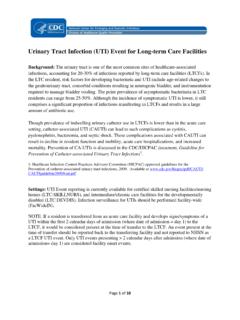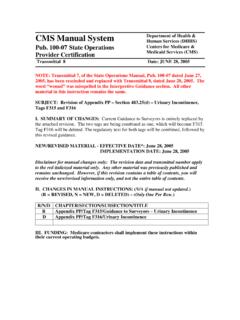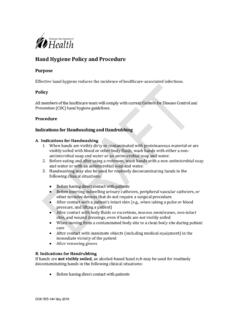Transcription of Indwelling Urinary Catheter Insertion and Maintenance
1 Indwelling Urinary Catheter Insertion and MaintenancePresenterMilisaManojlovich, PhD, RN, CCRNP rofessor of NursingUniversity of MichiganContributions byKristi Felix, RN, BSN, CRRN, CIC, FAPICM adonna Rehabilitation HospitalLinda Greene, RN, MPS, CIC, FAPICU niversity of Rochester, Highland HospitalJennifer Meddings, MD, MScUniversity of MichiganSanjay Saint, MD, MPHU niversity of MichiganBarbara W. Trautner, MD, PhDBaylor College of MedicineKaren Fowler, MPHU niversity of Michigan2 Learning Objectives Describe strategies for aseptic Insertion of Indwelling Urinary catheters Identify approaches to overcome barriers to Urinary Catheter aseptic Insertion Identify strategies to overcome barriers to Urinary Catheter maintenance3 Why is Aseptic Insertion So Important?
2 The rate of Catheter use may be rising About 15-25% of hospitalized patients CAUTI is costly and increases morbidity Bacteria can enter the bladder during Insertion Guidelines have always recommended aseptic Insertion of Indwelling Urinary catheters4( Catheter -associated Urinary Tract Infections (CAUTI), CDC, 2015)Components of the Catheter Insertion and Maintenance Bundle5(MeddingsJ, Saint S. Disrupting the life cycle of the Urinary Catheter . ClinInfect Dis. 2011;52(11):1291-3. PMID: 21596672.)Use a Standard Indwelling Urinary Catheter Kit Several different types of kits on the market Closed-system Catheter Insertion kits are recommended Supplies in each kit are organized by order of use Consider removing individual catheters from stock6 Ensure Proper Insertion Technique Aseptic Insertion technique is recommended Many nurses and other clinicians have to relearn proper technique Working environment does not resemble learning environment Inserting clinicians should receive competency-based training and be able to demonstrate Indwelling Catheter Insertion competency Practices should be observed and monitored in real world settings
3 After initial training. 7 Categories and Frequencies ofMajor Breaks in SterilityCategoryFrequency (%)ExamplesContamination of sterile field22 (27%) Nurse touched items on sterile field with bare non-sterile hands. Stethoscope/garment/torso touched sterile of the catheter25 (31%) Patient s labia closed over the Catheter during Insertion and contaminated the Catheter ; nurse did not get a new one. Catheter tip touched genitalia before being introduced into of sterile barrier31 (38%) Sterile gloved hand used to swab genitalia (without tongs); same hand used to insert Catheter . Nurse inserting Catheter ripped her sterile gloves, did not get new (Manojlovich M, Infect Control HospEpidemiol, 2016; Lo E, Infect Control HospEpidemiol2014.)
4 Carter EJ, Infect Control HospEpidemiol, 2016)Both Technical and Socio-Adaptive Strategies are Needed Technical Provide competency-based training for all staff inserting catheters Confirm availability of supplies needed for aseptic Insertion Ensure appropriate hand hygiene and personal protective equipment (PPE) use Use checklists to help streamline insertions and assure they are done aseptically Conduct routine audits and provide timely feedback on aseptic Insertion practices Socio-adaptive Unit culture Empower staff to stop procedures if aseptic technique is broken Recruit an Insertion champion Encourage the use of two people for Catheter insertions to help ensure no breaks in aseptic technique 9 ANA Tool.
5 Algorithm and Checklist10(ANA CAUTI Prevention Tool, ANA)Aseptic Insertion hand hygiene immediately before (and after) appropriate antiseptic or sterile solution for peri-urethral cleaning, remove gloves and perform hand hygiene after peri-urethral cleaning and prior to up a sterile sterile gloves, drapes, appropriate antiseptic single-use packet of lubricant jelly for Catheter the device collection bag below bladder level**If the Catheter is accidentally contaminated, discard it, and obtain a new sterile Catheter (or kit)11 Barriers to Aseptic Insertion Supplies are not readily available Supplies not designed to facilitate aseptic Insertion Wisps from cotton balls tend to cling to tongs in some kits Work space not aligned with workflow Inconsistent or inconvenient locations for hand gel Inconvenient location of sinks Inadequate space created to set up sterile field12 Strategies to Overcome Barriers Best type of kit to stock for your unit or hospital s patient population Other necessary supplies.
6 Over-the-bed tables E PA-registered disinfectant to clean and disinfect workspace Hand sanitizers Sterile gloves Adequate facilities for hand hygiene Accessibility/location of kits Where are kits located in relation to where procedure will take place?13 Maintenance : Catheter Care Essentials Use appropriate hand hygiene and gloves Properly secure catheters to prevent movement and urethral traction Maintain a sterile closed drainage system Maintain good hygiene at the Catheter -urethral interface Maintain unobstructed urine flow Maintain drainage bag below level of bladder at all times Do not change Indwelling catheters or drainage bags at arbitrary fixed intervalsDocument indication for Urinary Catheter on each day of use(Appendix I.)
7 Catheter Care Pocket Card, AHRQ, 2015)14 Hand Hygiene and Glove Use Perform hand hygiene beforeeach and every patient contact and beforeany manipulation of the Catheter device or site Strategies to improve hand hygiene and glove use: Education related to specific aspects of Urinary Catheter care Audit and feedback15(Gould CV, Infect Control HospEpidemiol, 2009; Lo E,Infect Control HospEpidemiol,2014; WHO Guidelines on Hand Hygiene in Health Care, WHO, 2009)Maintain a Closed System16 If breaks in aseptic technique, disconnection or leakage occur, replace the Catheter using aseptic technique and sterile equipment Consider using Urinary catheters with pre-connected, sealed Catheter tubing junctions(Gould CV, Infect Control HospEpidemiol, 2009)Strategies to Maintain a Closed System17 Work with your supply chain to request that vendors supply pre-connected Indwelling Urinary catheters(Information for Specialty Audiences, AHRQ, 2016)
8 Ensure Indwelling catheters are only inserted when clinically indicated Consider pre-connected urimeters If a patient requires a single irrigation, change the entire system after or consider inserting a 3- WayMaintain Unobstructed Urine Flow Maintain the bag below the level of the bladder Ensure that the bag is emptied prior to transport Use a Catheter securement device to anchor the Catheter Keep the urine bag off the floor 18 Strategies to Maintain Unobstructed Flow Incorporate observation of Urinary Catheter and bag into routine rounds Perform a simple check prior to transport to ensure that all lines and catheters are patent Is the Catheter secure?
9 Is the drainage bag empty?19 Meatal Cleaning:Soap and Water is Best! 20 Perform periand Catheter care per facility policy Assess the patient for any pain or discomfort Inspect the meatus for redness, irritation and drainage Assess the Catheter where it enters the meatus for encrusted material and drainage Clean the meatus during daily bathing (donot clean with antiseptics) Remove any encrusted materials on the tubing Ensure the tubing doesnot go in and out of the urethra during cleaning(Gould CV, Infect Control HospEpidemiol, 2009) Maintenance Checklist21(HanchettM, APIC, 2012)Take Home Points Consider the use of checklists Explore how the unit culture affects your ability to insert and maintain Indwelling Urinary catheters according to evidence-based guidelines If the patient must have an Indwelling Urinary Catheter , pay attention to Maintenance practices It s NOT complicated: simple can be better (such as using soap and water for periurethralcare)22 References Appendix I.
10 Catheter Care Pocket Card. Content last reviewed October 2015. Agency for Healthcare Research and Quality, Rockville, MD. Appendix J. Urinary Catheter Brochure. October 2015. Agency for Healthcare Research and Quality, Rockville, MD. Available at Carter EJ, PallinDJ, Mandel L, et al. Emergency department Catheter -associated Urinary tract infection prevention: multisite qualitative study of perceived risks and implemented strategies. Infect Control HospEpidemiol. 2016; 37(2): 56-62. Catheter -Associated Urinary Tract Infections (CAUTI). Healthcare-Associated Infections. Centers for Disease Control and Prevention, CDC. Accessed May 10, 2016.
















